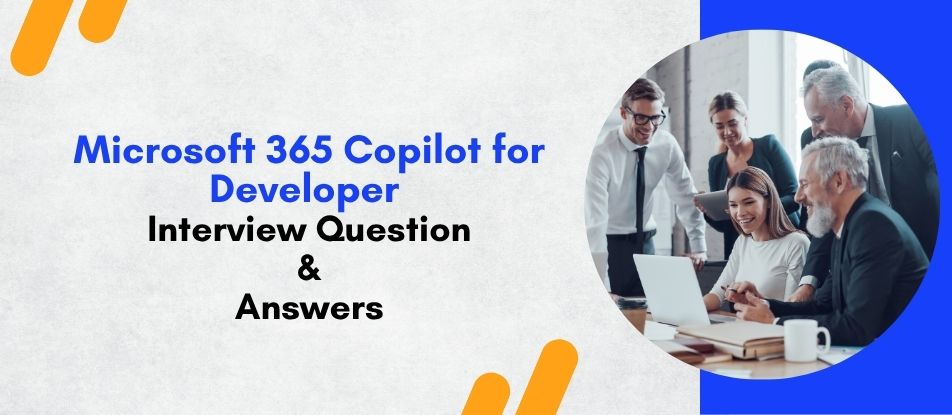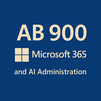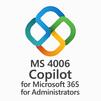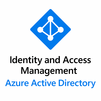
Master the art of building intelligent solutions with Microsoft 365 Copilot for Developer training. This course teaches developers how to extend Copilot using custom plugins, Microsoft Graph API, adaptive cards, and conversational AI techniques. Learn to integrate enterprise data securely, enhance user interactions, and optimize performance across Microsoft 365 apps like Word, Excel, Teams, and Outlook. Gain expertise in grounding AI responses, semantic indexing, and delivering enterprise-grade Copilot experiences.
Microsoft 365 Copilot for Developer Training Interview Questions Answers - For Intermediate
1. What are Microsoft 365 Copilot scenarios where developer customization is most valuable?
Developer customization adds the most value when extending Copilot to integrate external systems, automate repetitive business processes, or provide vertical-specific insights (e.g., finance, healthcare, manufacturing). By building plugins or using Microsoft Graph, developers enable Copilot to surface data or trigger actions beyond the native Microsoft 365 ecosystem, enhancing productivity and delivering personalized user experiences.
2. What are the key security considerations when building Copilot plugins?
Key security considerations include implementing OAuth 2.0 authentication, ensuring that APIs validate access tokens, encrypting sensitive data, protecting against injection attacks, and enforcing least-privilege access. It’s also critical to log API activity for auditing and monitor usage patterns to detect anomalies. Plugins must comply with organizational and regulatory security standards.
3. How can Copilot be used in Microsoft Teams applications?
Within Teams, Copilot enhances productivity through conversational AI, message extensions, and adaptive cards. Developers can build Teams apps with plugins that Copilot can invoke during chats or meetings. This enables scenarios like pulling CRM data, automating approvals, or summarizing meeting notes—all surfaced via Copilot in the Teams interface.
4. What are Copilot Pro and Copilot Studio?
Copilot Pro is a premium offering that provides enhanced AI capabilities and advanced integrations for power users. Copilot Studio is a low-code tool that allows developers and citizen developers to create custom copilots and conversational apps. It helps accelerate Copilot extensibility without deep coding, though more advanced plugins still require professional development.
5. What is grounding in the context of Microsoft 365 Copilot?
Grounding refers to the process of ensuring that Copilot responses are based on accurate, up-to-date organizational data. This is achieved by combining the large language model’s capabilities with real-time data from Microsoft Graph and plugins. Developers play a role in grounding by exposing high-quality APIs and ensuring their plugins return reliable information.
6. How does Copilot leverage Azure OpenAI Service?
Microsoft 365 Copilot uses Azure OpenAI Service to power its large language model capabilities, such as understanding natural language prompts and generating human-like responses. Developers can also use Azure OpenAI to add domain-specific AI models or fine-tuned solutions to their Copilot plugins, bringing even more intelligence to enterprise workflows.
7. What is the lifecycle of a Copilot plugin?
The typical lifecycle involves designing the API and OpenAPI spec, registering the app in Azure AD, deploying the plugin endpoint, validating it in development environments, obtaining admin approval for production use, monitoring its behavior, and iteratively improving it based on telemetry and user feedback. Continuous testing is key for maintaining high plugin quality.
8. What are Microsoft 365 Copilot extensibility entry points?
Entry points include Microsoft Word, Excel, Teams, Outlook, and PowerPoint. Developers can build Copilot plugins that work across multiple apps or tailor them to specific entry points. For example, a financial reporting plugin might surface insights in Excel, while a project management plugin might provide summaries in Teams.
9. How do developers handle error handling in Copilot plugins?
Plugins should implement robust error handling by returning clear HTTP status codes (e.g., 400, 404, 500) and meaningful error messages in the API responses. Adaptive cards should gracefully inform users of issues and suggest next steps. Logging errors to Application Insights or another telemetry service is also recommended for debugging and continuous improvement.
10. What is the role of prompt engineering in Copilot plugin development?
Prompt engineering involves crafting optimized natural language prompts and responses to guide Copilot behavior. While the AI handles most of the interpretation, developers influence the experience by designing plugin APIs to align with likely user prompts and ensuring that responses are concise, relevant, and actionable. This improves user satisfaction and trust in the Copilot.
11. How can Microsoft 365 Copilot be used with the Power Platform?
Copilot integrates with Power Platform tools like Power Automate, Power Apps, and Power BI. Developers can create Copilot experiences that trigger Power Automate flows, display Power BI dashboards, or call custom connectors. This allows users to automate business processes or generate insights through natural language interactions with Copilot.
12. How can developers ensure performance optimization of Copilot plugins?
To optimize performance, developers should implement fast, scalable APIs with minimal latency. Caching strategies, database indexing, and efficient query design are crucial. They should also adhere to Microsoft’s guidance on rate limits and design plugins that return lightweight, targeted responses rather than overly verbose data.
13. What telemetry data should developers collect from Copilot plugins?
Developers should collect data such as API invocation counts, success vs. error rates, response times, user interaction patterns with adaptive cards, and plugin usage trends across different Microsoft 365 apps. This telemetry helps identify issues, guide improvements, and demonstrate the business value of the plugin.
14. How does tenant-specific customization work with Copilot?
Tenant-specific customization allows developers to tailor Copilot behavior to an organization’s needs. This can include customizing the plugin’s logic based on tenant settings, adjusting API responses based on user roles, and providing tenant-specific adaptive cards or conversational prompts. It ensures that Copilot aligns with the organization’s business context.
15. What are key testing strategies for Copilot plugins?
Testing strategies include unit testing APIs, validating OpenAPI specs, using Teams Developer Portal for simulated Copilot interactions, performing functional testing in test tenants, and conducting user acceptance testing (UAT). Developers should also monitor telemetry post-deployment and implement CI/CD pipelines to ensure rapid, reliable plugin updates.
Microsoft 365 Copilot for Developer Training Interview Questions Answers - For Advanced
1. How can developers create domain-specific copilots, and what tools are available for this?
Developers can create domain-specific copilots by combining Microsoft 365 Copilot extensibility with industry-specific data models and business logic. Tools like Copilot Studio (formerly Power Virtual Agents advanced authoring) allow for the creation of custom conversational flows without extensive code. For more advanced scenarios, developers can use OpenAI services on Azure to fine-tune large language models or train industry-specific embeddings. Plugins can be developed with custom APIs to surface proprietary data into Copilot, and developers can map their domain knowledge into Semantic Index so that Copilot delivers highly contextual and relevant responses. Integration with Power Platform, Graph Data Connect, and custom connectors further allows developers to enrich Copilot experiences with domain-specific workflows and automation.
2. How can developers balance user experience with security when designing Copilot plugins?
Balancing user experience with security is a key challenge. Developers should first implement zero trust principles—authenticating every API call and enforcing least-privilege access. At the same time, responses should remain seamless and interactive, not requiring unnecessary user authentication prompts. Single sign-on (SSO) can reduce friction while maintaining security. Sensitive data should never be overexposed in adaptive cards, and data masking or role-based filtering can ensure users see only what they are authorized to access. Furthermore, plugins should provide graceful degradation—if a security policy prevents certain data access, the plugin should clearly inform the user and offer alternatives instead of failing silently.
3. What is retrieval-augmented generation (RAG), and how does it apply to Copilot plugin development?
Retrieval-augmented generation (RAG) is a hybrid approach that combines the strengths of knowledge retrieval systems (such as search indexes or Graph APIs) with language generation models. In Copilot, this allows responses to be grounded in live data rather than relying purely on pre-trained LLM knowledge. Developers can implement RAG by creating plugins that fetch real-time data (via REST APIs or Microsoft Graph), which Copilot then uses to enhance its natural language outputs. For example, when a user asks for "the latest sales trends," the plugin retrieves current CRM data, and Copilot synthesizes the narrative from that grounded data. This architecture improves factual accuracy and trustworthiness of AI-driven responses.
4. How can developers manage scalability when their Copilot plugin is being used by large enterprise tenants?
Scalability is critical when serving large enterprises with thousands of users. Developers should adopt cloud-native design patterns, such as serverless computing with Azure Functions or containerized microservices with Azure Kubernetes Service. APIs should implement horizontal scaling, stateless processing, and caching (for read-heavy scenarios). Rate limiting and throttling controls are also needed to prevent misuse or excessive load. Additionally, plugins should be instrumented with telemetry to monitor API usage patterns and automatically adjust capacity as needed. Using Azure API Management (APIM) provides an additional layer to control, secure, and monitor API traffic.
5. How do plugins integrate with Microsoft 365’s data residency and compliance requirements?
When integrating with Microsoft 365, plugins must respect data residency—keeping customer data within the geographic boundaries mandated by the tenant’s compliance policies. Developers should ensure their APIs are hosted in compliant Azure regions and clearly communicate any data flow to Microsoft 365 admins. For plugins dealing with regulated industries (finance, healthcare), compliance certifications (such as ISO 27001, SOC 2, HIPAA) should be provided. Developers can also implement data classification labels and integrate with Microsoft Purview to manage sensitive data appropriately within Copilot experiences.
6. How can developers implement conversational memory within a Copilot plugin?
While Copilot maintains session-level conversational context, developers can implement persistent memory by using conversation state management in their backend systems. For example, using Azure Cosmos DB or Azure Table Storage, plugins can store session variables, user preferences, or recent interactions. This enables advanced use cases like personalized recommendations or multi-turndialogues where the plugin remembers past interactions across multiple Copilot sessions. The key is to manage memory securely, ensuring user consent and data minimization while respecting Microsoft’s compliance framework.
7. What are effective techniques for debugging and testing Copilot plugins in development?
Effective debugging involves several layers. Developers should implement comprehensive logging for API invocations, payloads, and adaptive card interactions. During testing, they can use Microsoft Teams Developer Portal, Postman, and Graph Explorer to validate APIs and simulate Copilot interactions. Unit tests and integration tests should be automated via CI/CD pipelines (using tools like GitHub Actions or Azure DevOps). Additionally, developers should test prompt variability—ensuring that the plugin behaves correctly across a wide range of user inputs. Telemetry dashboards using Azure Monitor or Application Insights can provide real-time insights during testing and production.
8. How does adaptive card interactivity enhance Copilot scenarios, and what are design best practices?
Adaptive cards bring rich interactivity into Copilot responses, transforming passive text into actionable experiences. For example, cards can allow users to filter results, trigger workflows, or input data directly within Teams or Outlook. Best practices include prioritizing clarity and accessibility, keeping cards lightweight and mobile-friendly, and ensuring that actions are idempotent (so users can safely retry them). Developers should test cards across dark/light themes and localization scenarios. Cards should also degrade gracefully—falling back to plain text if the consuming app does not support rich cards.
9. How can developers incorporate responsible AI principles into Copilot plugin design?
Developers play a critical role in ensuring responsible AI within Copilot experiences. They should follow Microsoft’s AI principles—fairness, reliability, safety, privacy, inclusiveness, transparency, and accountability. In practice, this means validating that plugin outputs do not propagate bias, misinformation, or harmful content. API responses should be auditable and explainable where possible, providing traceability for how an AI-driven conclusion was reached. Developers should implement fallback messages if the plugin cannot confidently serve a user request, avoiding the temptation to generate speculative or inaccurate responses.
10. How can developers leverage Microsoft Graph Connectors in tandem with Copilot plugins?
Microsoft Graph Connectors allow developers to index external data (ERP, CRM, document management systems) into Microsoft Graph, making it discoverable and searchable by Copilot. When combined with plugins, this enables a hybrid model—Copilot can retrieve structured insights via plugins while also surfacing indexed content through semantic search. For example, a developer might index legal documents using a Graph Connector and expose a contract review workflow via a plugin, enabling complementary and context-rich Copilot experiences.
11. What role does grounding with Microsoft Graph APIs play in preventing hallucinations?
Grounding Copilot responses with Microsoft Graph APIs is one of the best ways to prevent hallucinations (fabricated or inaccurate AI outputs). When Copilot retrieves data directly from trusted enterprise sources—such as calendar events, emails, files, or Teams chats—the LLM can generate responses anchored in verifiable facts. Developers should design plugins to prefetch and structure this data before invoking the LLM, so the model has an accurate context to work from. Additionally, prompt engineering should remind the model to prioritize grounded data over generative speculation.
12. How can developers design for extensibility across different Microsoft 365 apps (Word, Teams, Outlook, etc.)?
Designing plugins to work across multiple Microsoft 365 apps requires modular architecture. Developers should separate core business logic from UI-specific rendering. For example, a backend API might return a neutral data model, and separate adaptive card templates can be used for Teams, Outlook, or Word. Plugins should also handle different interaction modes—Teams is conversational, Word is document-centric, Outlook is email-focused. Thorough testing across these entry points ensures a consistent, high-quality user experience.
13. How do Copilot plugins support dynamic personalization for individual users?
Plugins can support dynamic personalization by accessing user-specific context via Microsoft Graph—such as user profile, recent activity, preferred language, or role. Additionally, developers can maintain user-specific settings (e.g., via Azure Cosmos DB) to tailor plugin behavior to individual needs. For example, a sales assistant Copilot might adjust its recommendations based on the user’s territory or past deals. Personalization should always respect privacy and offer opt-in/opt-out mechanisms for transparency.
14. How can developers align plugin responses with enterprise governance and policies?
To align with enterprise governance, developers should integrate with Microsoft Purview (formerly Compliance Center) for data classification and DLP (data loss prevention) enforcement. Plugins can also use Graph Security API to respect enterprise sensitivity labels and information barriers. Additionally, plugins should expose auditing hooks so that governance teams can monitor usage and compliance. Aligning plugin outputs with enterprise legal disclaimers or corporate tone of voice is also recommended to ensure brand and legal alignment.
15. What is the role of feedback loops in improving Copilot plugin performance, and how should they be implemented?
Feedback loops are essential for continuous improvement of Copilot plugins. Developers should implement user feedback mechanisms (thumbs up/down, comments) and log this feedback alongside telemetry (API response times, error rates, user engagement metrics). Using AI-based analysis, developers can identify patterns in what works and what doesn’t. Regularly reviewing feedback with product owners and user champions enables iterative refinements—improving grounding, enhancing prompt clarity, and tuning API behavior. Ultimately, this creates a virtuous cycle where plugins become smarter and more valuable over time.
Course Schedule
| Jan, 2026 | Weekdays | Mon-Fri | Enquire Now |
| Weekend | Sat-Sun | Enquire Now | |
| Feb, 2026 | Weekdays | Mon-Fri | Enquire Now |
| Weekend | Sat-Sun | Enquire Now |
Related Courses
Related Articles
- CI/CD Pipeline: The Backbone of Modern Software Development
- Security and Compliance with IBM Websphere Transformation Extender - Essentials
- Boost Your Career with Professional Saviynt Online Training
- How Workday SCM Training Can Propel Your Career Forward
- From Learner to Expert: Aveva E3D Admin Explained
Related Interview
Related FAQ's
- Instructor-led Live Online Interactive Training
- Project Based Customized Learning
- Fast Track Training Program
- Self-paced learning
- In one-on-one training, you have the flexibility to choose the days, timings, and duration according to your preferences.
- We create a personalized training calendar based on your chosen schedule.
- Complete Live Online Interactive Training of the Course
- After Training Recorded Videos
- Session-wise Learning Material and notes for lifetime
- Practical & Assignments exercises
- Global Course Completion Certificate
- 24x7 after Training Support











 Join our Live Instructor-Led online classes delivered by industry experts
Join our Live Instructor-Led online classes delivered by industry experts